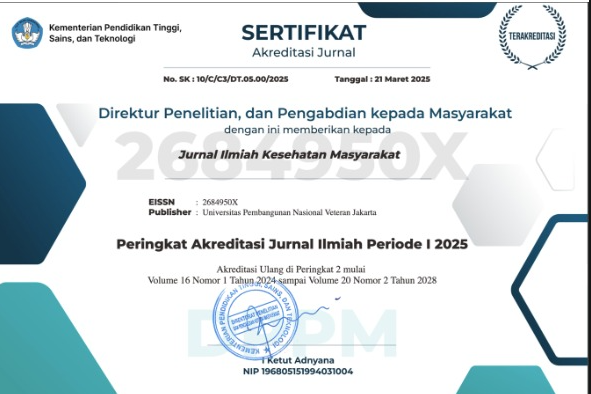Pengaruh Keturunan, Obesitas dan Gaya Hidup yang Mempengaruhi Risiko Hipertensi pada Lansia di Wilayah Kerja Puskesmas Pandak II Bantul DIY Tahun 2019
Abstract
Abstrak
Latar belakang: Hipertensi adalah keadaan di mana tekanan darah sistolik ≥ 120 mmHg atau Diastolik ≥ 90 mmHg. Beberapa penyebabnya adalah keturunan, obesitas dan gaya hidup. Tujuan dari penelitian ini adalah untuk mengetahui pengaruh antara keturunan, obesitas dan gaya hidup terhadap risiko hipertensi pada lansia di wilayah kerja Puskesmas Pandak II Bantul DIY.
Metode: Penelitian ini bersifat deskriptif kuantitatif dengan pendekatan case control. Sampel diambil dengan teknik purposive sampling menggunakan perbandingan 1:1. Pengambilan sampel dengan kriteria inklusi dan eksklusi yaitu sebanyak 62 responden. Pengujian data menggunakan uji univariat dan bivariat. Instrumen penelitian yang digunakan dalam penelitian ini adalah kuesioner pengetahuan dan pengukuran pada obesitas menggunakan timbangan serta meteran dan pengukuran hipertensi menggunakan spinomamometer dan stetoskop.
Hasil: Hasil dari analisis bivariat didapatkan nilai asymp sig (0,002) < α (0,05) yang berarti terdapat pengaruh yang sigifikan antara keturunan terhadap risiko hipertensi di wilayah kerja Puskesmas Pandak II Bantul DIY. Hasil asymp sig dari obesitas adalah (0,575) > α (0,05) maka Ho diterima, artinya tidak ada pengaruh yang siginifikan antara variabel obesitas terhadap risiko hipertensi di wilayah kerja Puskesmas Pandak II Bantul DIY. Dan hasil gaya hidup adalah asymp sig (0,015) < α (0,05) yang berarti terdapat pengaruh yang sigifikan antara gaya hidup terhadap risiko hipertensi di wilayah kerja Puskesmas Pandak II Bantul DIY.
Kesimpulan: Terdapat pengaruh yang signifikan antara keturunan terhadap risiko hipertensi, tidak terdapat pengaruh yang signifikan antara obesitas terhadap risiko hipertensi dan terdapat pengaruh yang signifikan antara gaya hidup terhadap risiko hipertensi di wilayah kerja Puskesmas Pandak II Bantul DIY.
The influence of Heredity, Obesity and lifestyle which Affect the Risk of Hypertension in the Elderly in the Working Area of Puskesmas Pandak II Bantul DIY 2019
Abstract
Background: Hypertension is a condition where the systolic blood pressure ≥ 120 mmHg or Diastolic ≥ 90 mmHg. Some of the causes are heredity, obesity and a sedentary lifestyle. The purpose of this study is to identify the influence of heredity, obesity and lifestyle on the risk of hypertension in the elderly in the working area of Puskesmas Pandak II Bantul DIY.
Method: This research is a descriptive quantitative case-control approach. Samples were taken with purposive sampling technique using a 1:1 comparison. Sampling with inclusion and exclusion criteria as many as 62 respondents. Testing test data using univariate and bivariate. The research instrument used in this study is a questionnaire of knowledge and measurement in obesity using the scales as well as the meter and the measurement of hypertension using the spinomamometer and stethoscope.
Results: The results of the bivariate analysis the obtained value of asymp sig (0,002) < α (0.05) which means there is influence significantly between offspring against the risk of hypertension in Puskesmas Pandak II Bantul DIY. The results of the asymp sig of obesity is (0,575) > α (0.05), then Ho is accepted, meaning that there is no influence that is significant between the variables of obesity on the risk of hypertension in Puskesmas Pandak II Bantul DIY. And life style results is asymp sig (0,015) < α (0.05) which means there is influence significantly between the lifestyle against the risk of hypertension in Puskesmas Pandak II Bantul DIY.
Conclusion: The conclusion from this research is there are influence which significant between breeds to the risk of hypertension, there is no significant influence of obesity on the risk of hypertension and there is significant influence between the life style on the risk of hypertension in Puskesmas Pandak II Bantul DIY.
References
Lucky A. Hipertensi: The Silent Killer. Jakarta: Yayasan Penerbitan Ikatan Dokter Indonesia; 2010.
Zuraidah, Maksuk, Apriliadi N. Analisis Faktor Risiko Penyakit Hipertensi pada Masyarakat di Kecamatan Kemuning Kota Palembang. J Kesehat Poltekkes Palembang [Internet]. 2012;1(10):170–8. Available from: poltekespalembang.ac.id
Anies. Waspada Ancaman Penyakit Tidak Menular. Jakarta: PT. Elex Media Kompetindo; 2006.
Isnan N, Lestari IG. Pengaruh Self Management Terhadap Tekanan Darah Lansia Yang Mengalami Hipertensi. Indones J Heal Sci. 2018;2(1).
Yuli HS, Usman, Makhrajani M. Faktor-faktor yang Berhubungan terhadap Kejadian Hipertensi pada Lansia di Wilayah Kerja Puskesmas Maiwa Kabupaten Enrekang. J Ilm Mns dan Kesehat [Internet]. 2019;2(1). Available from: https://jurnal.umpar.ac.id/index.php/makes/article/view/125
Suriatun, Ruhyana. Analisis Faktor – faktor Yang Mempengaruhi Kejadian Hipertensi di Posyandu Lansia Dusun Pundung Nogotirto Gamping Sleman Yogyakarta. Aisyiyah Yogyakarta; 2018.
Arifin M, Weta IW, Ratnwati NLK. Faktor-faktor yang Berhubungan dengan Kejadian Hipertensi pada Kelompok Lanjut Usia di Wilayah Kerja UPT Puskesmas Petang I Kabupaten Bandung. J Med Udayana [Internet]. 2016;5(7). Available from: https://ojs.unud.ac.id/index.php/eum/article/view/21559
Suoth M, Bidjuni H, Malara R. Hubungan Gaya Hidup dengan Kejadian Hipertensi di Puskesmas Kolongan Kecamatan Kalawat Kabupaten Minahasa Utara. J Keperawatan. 2014;2(1).
Taslima, Husna A. Hubungan Riwayat Keluarga dan Gaya Hidup Dengan Hipertensi pada Lansia di Puskesmas Kuta Alam Banda Aceh. J Heal Care Technol Med. 2017;3(1).









.jpg)








